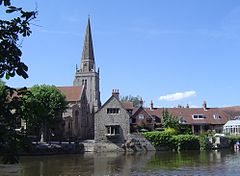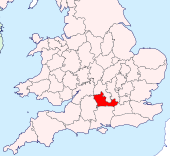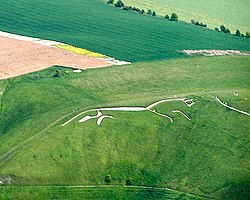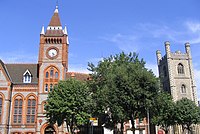Berkshire: Difference between revisions
No edit summary |
|||
| Line 72: | Line 72: | ||
* [[Newbury]] | * [[Newbury]] | ||
* [[Reading]] ''(partly in [[Oxfordshire]])'' | * [[Reading]] ''(partly in [[Oxfordshire]])'' | ||
* [[Sandhurst]] | * [[Sandhurst, Berkshire|Sandhurst]] | ||
* [[Thatcham]] | * [[Thatcham]] | ||
* [[Twyford, Berkshire|Twyford]] | * [[Twyford, Berkshire|Twyford]] | ||
Latest revision as of 22:24, 3 April 2021
| Berkshire United Kingdom | |
 The River Thames at Abingdon, looking towards St. Helen's parish church | |
|---|---|

| |
| Flag | |

| |
| [Interactive map] | |
| Area: | 722 square miles |
| Population: | 842,804 |
| County town: | Reading or Abingdon |
| Biggest town: | Reading |
| County flower: | Summer snowflake [1] |
Berkshire is a Royal County in southern England, lying along the south bank of the River Thames. It is usually regarded as one of the home counties.
The county's honorific prefix Royal, which dates to the 19th century at least, is because of the presence of the royal residence of Windsor Castle in the county. This was recognised by the Queen in 1958, and letters patent were issued confirming it in 1974.[1]
Berkshire borders six other counties: Hampshire directly to the south; Surrey to the south-east; Wiltshire to the south-west; Oxfordshire and Buckinghamshire, which lie to the north, across the Thames; and Gloucestershire, with which Berkshire has a five-mile boundary at its north-western corner by Buscot.
The county town was long considered to be Abingdon, where the county's justices of the peace met, but in 1867 when the Summer assizes moved to Reading, many have considered this to have moved the county town.[2]
As part of a 2002 campaign, the plant conservation charity Plantlife chose the summer snowflake (the 'Loddon Lily') as the county flower.
Geography

Berkshire lies entirely south of the River Thames, which forms the county's northern boundary. Berkshire follows the Thames uninterruptedly for 103 miles from Buscot to Old Windsor. The riverbank is marked with numerous pretty towns and villages.
Berkshire's landscape divides into two clearly distinct sections with the boundary lying roughly on a north-south line through the centre of Reading.
In eastern Berkshire are several important tributaries of the Thames, including the Loddon and Blackwater which increase the amount of low-lying riverine land in the area. Beyond the flood plains, the land rises gently to the county boundaries with Surrey and Hampshire. Much of this area is still well wooded, especially around Bracknell and Windsor Great Park.
In western Berkshire are two rich valleys separated by the Berkshire Downs. The Berkshire Downs are geologically an extension of the Chiltern Hills, and force the Thames to turn sharply south until it forces its way between the Chilterns in Oxfordshire and the Berkshire Downs at the Goring Gap, a breach made apparently at the end of the last Ice Age. The Berkshire Downs are cut with small and well-wooded valleys draining into the River Lambourn, River Pang and their tributaries, and open upland areas famous for their involvement in horse racing and training.
To the north, between the Berkshire Downs and the Thames, is the Vale of White Horse, named after the famous Uffington White Horse. The Vale is watered by numerous brooks which gradually join to make the River Ock a noble stream by the time it empties into the Thames at Abingdon.
South of the Berkshire Downs runs the valley of the River Kennet, which joins the Thames in Reading. Fairly steep slopes on each side delineate the river's flat floodplain. To the south, the land rises steeply to the boundary with Hampshire, and here are found the highest parts of the county, the county top being Walbury Hill at 974 feet, which is also the highest point in south-east England.
The county has two detached parts: the parish of Shilton, locally situate in Oxfordshire; and on the borders of Oxfordshire and Gloucestershire, the parishes of Little Faringdon and Langford.
Hundreds
The county is divided into 20 hundreds:
Major Towns

The largest towns in Berkshire by population are:
- Abingdon
- Ascot
- Bracknell
- Didcot
- Faringdon
- Maidenhead
- Newbury
- Reading (partly in Oxfordshire)
- Sandhurst
- Thatcham
- Twyford
- Wallingford
- Wantage
- Windsor
- Wokingham
Additionally the city of Oxford, otherwise in Oxfordshire, extends into Berkshire.
History

The county is one of the oldest in England. It may date from the 840s, for in 848 King Cenwalh granted "three thousand hides by Ashdown" to Cuthred his kinsman.[3] The county is first mentioned by name in 860. According to Asser, it takes its name from a large forest of box trees that was called Bearroc (believed, in turn, to be a British language word meaning "hilly").[4]
Berkshire has been the scene of many battles throughout history, during King Alfred the Great's campaign against the Danes, including the Battle of Englefield, the Battle of Ashdown and the Battle of Reading.
During the Civil War there were two battles in Newbury. During the Glorious Revolution of 1688, there was a second Battle of Reading, a skirmish also known as the "Battle of Broad Street", the only battle of the Glorious Revolution fought in England.
Reading grew during the nineteenth century and in 1867 the county justices of the peace began to sit here.[5]
In the twentieth century Berkshire was at the forefront of new technology; the first nuclear power station was built at Harwell and toward the end of the century new computer industries began to congregate around Bracknell and Reading, where they remain dominant industries.
Economy
Information technology
The information technology industry is concentrated in eastern Berkshire, in particular in and around Reading, Bracknell and Wokingham.
Agricultural produce
A number of distinctive cheeses are produced in Berkshire, including Wigmore, Barkham blue and Waterloo cheeses.
Sport
One football club from the county plays professional football; Reading FC, who were formed in 1871.
The London Irish rugby club also ground-share with Reading FC at the Madejski Stadium.
Places of interest
| Key | |
| Cathedral/Abbey/Priory | |
| Accessible open space | |
| Amusement/Theme Park | |
| Castle | |
| Country Park | |
| English Heritage | |
| Forestry Commission | |
| Heritage railway | |
| Historic House | |
| Museum (free/not free) | |
| National Trust | |
| Zoo | |
 County Hall, Abingdon (Abingdon County Hall Museum)[6] Berkshire's 17th century County Hall
County Hall, Abingdon (Abingdon County Hall Museum)[6] Berkshire's 17th century County Hall Ashdown House – 17th century country house in the Berkshire Downs
Ashdown House – 17th century country house in the Berkshire Downs Basildon Park
Basildon Park- Beale Park
 Berkshire Downs
Berkshire Downs Bisham Abbey
Bisham Abbey Buscot Park, Buscot – 18th century country house and landscape garden
Buscot Park, Buscot – 18th century country house and landscape garden California Country Park, Finchampstead
California Country Park, Finchampstead Champs Chapel Museum of East Hendred
Champs Chapel Museum of East Hendred Cholsey and Wallingford Railway
Cholsey and Wallingford Railway Combe Gibbet
Combe Gibbet Didcot Railway Centre – museum of the Great Western Railway
Didcot Railway Centre – museum of the Great Western Railway Donnington Castle
Donnington Castle Frogmore House
Frogmore House Great Coxwell Barn – 14th century Tithe barn
Great Coxwell Barn – 14th century Tithe barn Greenham Common
Greenham Common Lardon Chase, the Holies and Lough Down
Lardon Chase, the Holies and Lough Down- Legoland Windsor
 Museum of English Rural Life
Museum of English Rural Life Museum of Reading
Museum of Reading- Reading Abbey
- Reading School
 North Wessex Downs Area of Outstanding Natural Beauty
North Wessex Downs Area of Outstanding Natural Beauty REME Museum of Technology
REME Museum of Technology The Ridgeway
The Ridgeway Stanlake Park Wine Estate
Stanlake Park Wine Estate Uffington White Horse, Uffington Castle and Wayland's Smithy burial chamber in the Vale of the White Horse
Uffington White Horse, Uffington Castle and Wayland's Smithy burial chamber in the Vale of the White Horse Milton Manor House – 18th century country house
Milton Manor House – 18th century country house Walbury Hill (county top and hill fort)
Walbury Hill (county top and hill fort) Wallingford Museum
Wallingford Museum Welford Park
Welford Park Windsor Castle
Windsor Castle Windsor Great Park
Windsor Great Park
See also
References
- ↑ Berkshire Record Office. "Berkshire, The Royal County". Golden Jubilee 2002 collection. http://www.berkshirerecordoffice.org.uk/collections/jubilee/jubilee_story4.htm. Retrieved 2007-04-22.
- ↑ Summer assizes were moved from Abingdon in 1867, effectively making Reading the county town. However, the Home Office informed the county's court of quarter sessions that in moving the court they had acted ultra vires, and that they were required to petition the privy council to make the change. The petition was duly submitted and the change was officially approved with effect from the summer of 1869. "Berkshire Quarter Sessions". Jackson's Oxford Journal. 4 July 1868.
- ↑ Anglo-Saxon Chronicle 848: Her Cenwalh gesalde Cuþrede his mæge .iii. þusendo londes be æscesdune
- ↑ "Dictionary.com". http://dictionary.reference.com/browse/berkshire. Retrieved 2008-11-08.
- ↑ http://www.berkshirehistory.com/villages/abingdon.html berkshirehistory.com
- ↑ Abingdon County Hall Museum
Outside links
- Royal Berkshire History
- Berkshire Enclosure Maps Digital copies of Berkshire enclosure maps and awards 1738-1883
- "Victoria County History: Berkshire". British History Online. http://www.british-history.ac.uk/subject.aspx?subject=5&gid=2. Retrieved 2009-07-13.
| Counties of the United Kingdom |
|---|
|
Aberdeen • Anglesey • Angus • Antrim • Argyll • Armagh • Ayr • Banff • Bedford • Berks • Berwick • Brecknock • Buckingham • Bute • Caernarfon • Caithness • Cambridge • Cardigan • Carmarthen • Chester • Clackmannan • Cornwall • Cromarty • Cumberland • Denbigh • Derby • Devon • Dorset • Down • Dumfries • Dunbarton • Durham • East Lothian • Essex • Fermanagh • Fife • Flint • Glamorgan • Gloucester • Hants • Hereford • Hertford • Huntingdon • Inverness • Kent • Kincardine • Kinross • Kirkcudbright • Lanark • Lancaster • Leicester • Lincoln • Londonderry • Merioneth • Middlesex • Midlothian • Monmouth • Montgomery • Moray • Nairn • Norfolk • Northampton • Northumberland • Nottingham • Orkney • Oxford • Peebles • Pembroke • Perth • Radnor • Renfrew • Ross • Roxburgh • Rutland • Selkirk • Shetland • Salop • Somerset • Stafford • Stirling • Suffolk • Surrey • Sussex • Sutherland • Tyrone • Warwick • West Lothian • Westmorland • Wigtown • Wilts • Worcester • York |